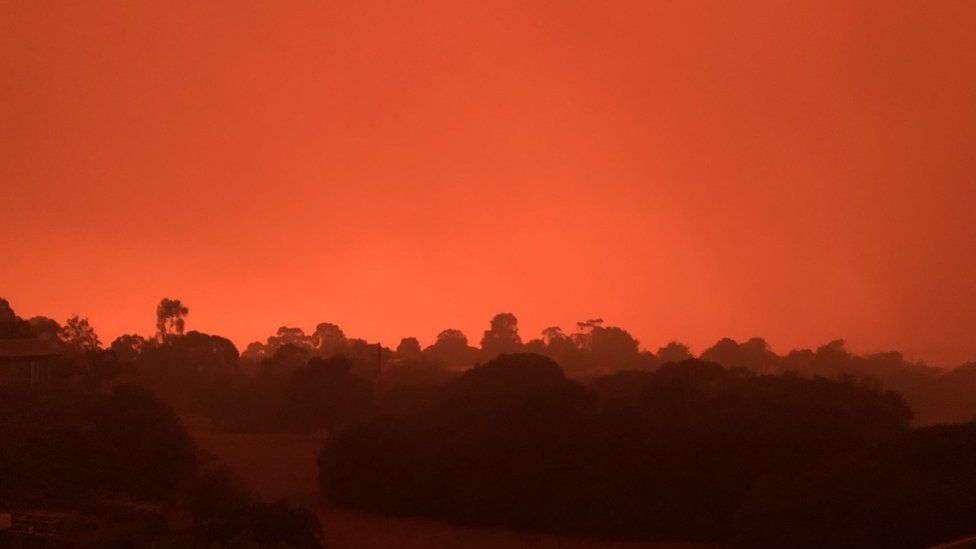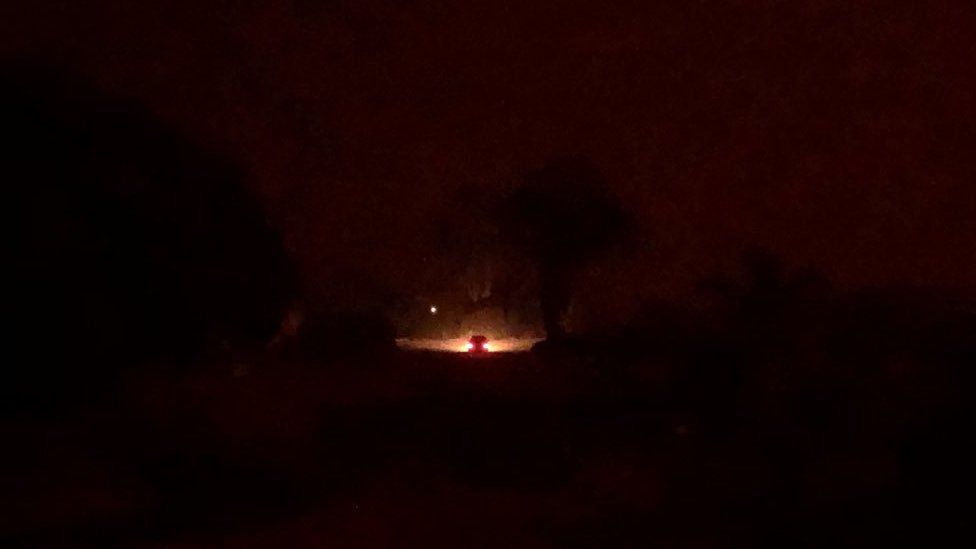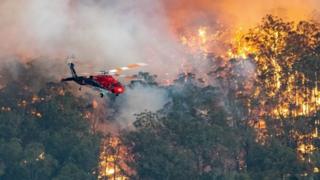SYDNEY (Reuters) - A third person was confirmed dead on Wednesday in devastating bushfires that engulfed Australia’s southeast coast this week and a fourth was missing and feared dead, as navy ships rushed to provide supplies and assist with evacuations.
Twelve people have now lost their lives in fire-related deaths across Australia since blazes broke out a few months ago, including three volunteer firefighters, after a three-year drought in large parts of the nation created tinder-dry conditions.
Fanned by soaring temperatures, columns of fire and smoke blackened entire towns on Monday and Tuesday, forcing thousands of residents and holidaymakers to seek shelter on beaches. Many stood in shallow water to escape the flames.
Bushfires have destroyed more than 4 million hectares (10 million acres) and new blazes are sparked almost daily by extremely hot and windy conditions and, most recently, dry lightning strikes created by the fires themselves.
Cooler conditions on Wednesday gave the country a moment to count the cost of the fires, although there were still more than 100 blazes in New South Wales (NSW) state alone and thousands of firefighters on the ground.
The body of a man was found in a burnt car early on Wednesday on the south coast of New South Wales after emergency workers began reaching the most damaged areas, and police said the death toll will rise.
“Sadly, we can report today that police have confirmed a further three deaths as a result of the fires on the South Coast,” NSW Police Deputy Commissioner Gary Worboys told reporters in Sydney.
“Police are also at Lake Conjola now, where a house has been destroyed by fire and the occupant of that home is still unaccounted for.”
NSW police did not identify the missing man but said he was 72 years old and authorities have been unable to reach his home.
Police said early assessments have found nearly 200 homes have been destroyed, though they cautioned it was an early estimate.
Large-scale livestock and animal casualties are also expected across Australia’s east coast, though Mogo Zoo - home to Australia’s largest collection of primates, along with zebras, white rhinos, lions, tigers and giraffes – was saved.
The wildlife park was threatened by an out-of-control bushfire, though zoo keepers and firefighters managed to save all 200 animals.
In Victoria state, four people remain missing, state Premier Daniel Andrews said, after a massive blaze ripped through Gippsland - a rural region about 500 km (310 miles) east of Melbourne.
About 4,000 people in the town of Mallacoota in Victoria headed to the waterfront after the main road was cut off.
Mark Tregellas, a resident of Mallacoota who spent the night on a boat ramp, said only a late shift in the wind direction spared lives.
“The fire just continued to grow and then the black started to descend. I couldn’t see the hand in front in my face, and it then it started to glow red and we knew the fire was coming,” Tregellas told Reuters.
“Ash started to fall from the air and then the embers started to come down. At that point, people started to bring their kids and families into the water. Thankfully, the wind changed and the fire moved away.”
In Milton, a small town on the on the NSW south coast, locals queued for hours for the few remaining items left of shelves on supermarkets.
Emma Schirmer, who evacuated from her house in Batemans Bay with her three-month child on Tuesday, said the local shop was limiting sales to six items per customer, while a power outage meant shoppers could pay only with cash.
As shops run low and firefighters struggle with exhaustion, Australia’s military, including Black Hawk helicopters, fixed-wing aircraft and naval vessels were being deployed.
“We’ve got choppers taking 90 firefighters out of the Mallacoota area, they can’t be removed any other way - we’re essentially doing a shift change by the air,” Andrews told reporters.
NSW Premier Gladys Berejiklian said authorities were working to restore communications with areas cut off by the fires, and she warned conditions will deteriorate again over the weekend.
“Weather conditions on Saturday will be as bad as they were” on Tuesday, Berejiklian told reporters in Sydney.
Meanwhile, Australia’s capital Canberra was blanketed in thick smoke, reaching about 20 times hazardous levels, prompting health warnings.
The smoke has also drifted to New Zealand where it has turned the daytime sky orange across the South Island.
PHOTOS/VIDEO
Australian bushfires claim third victim as authorities struggle to reach cut-off areas
SYDNEY (Reuters) - Australian authorities on Wednesday confirmed a third person had died in devastating bushfires that engulfed the southeast coastal region this week and said a fourth person was missing and feared dead.
Fanned by soaring temperatures, columns of fire and smoke blackened entire towns on Monday and Tuesday, forcing thousands of residents and holidaymakers to seek shelter on beaches. Many stood in shallow water to escape the flames.
In total, there have been 12 fire-related deaths across Australia since blazes broke out a few months ago, including three volunteer firefighters, after a three-year drought in large parts of the nation created tinder-dry conditions.
RELATED COVERAGE Head trusts officials on bushfire smoke in Sydney testHuge bushfires have destroyed more than 4 million hectares (10 million acres) — an area larger than Japan — and new blazes are sparked almost daily by extremely hot and windy conditions and, most recently, dry lightning strikes created by the fires themselves.
Cooler conditions on Wednesday gave the country a moment to count the cost of the fires, although there were still more than 100 blazes in New South Wales (NSW) state alone and thousands of firefighters on the ground.
The body of a man was found on Wednesday on the south coast of New South Wales after emergency workers began reaching the most damaged areas, according to the state’s Rural Fire Service (RFS).
The death toll is likely to rise, NSW RFS Commissioner Shane Fitzsimmons said.
“We still have grave concerns for (another person),” he told reporters in Sydney.
There is “limited access to the remote area to try to identify and confirm one way or the other the status of that person.”
Large-scale livestock and animal casualties are also expected across Australia’s east coast, though Mogo Zoo - home to Australia’s largest collection of primates, along with zebras, white rhinos, lions, tigers and giraffes – was saved.
The wildlife park was threatened by an out-of-control bushfire, though zoo keepers and firefighters managed to save all 200 animals.
In Victoria state, four people remain missing, authorities said, after a massive blaze ripped through Gippsland - a rural region about 500 km (310 miles) east of Melbourne.
About 4,000 people in the town of Mallacoota in Victoria headed to the waterfront after the main road was cut off.
Mark Tregellas, a resident of Mallacoota who spent the night on a boat ramp, said only a late shift in the wind direction sparred lives.
“The fire just continued to grow and then the black started to descend. I couldn’t see the hand in front in my face, and it then it started to glow red and we knew the fire was coming,” Tregellas told Reuters.
“Ash started to fall from the air and then the embers started to come down. At that point, people started to bring their kids and families into the water. Thankfully, the wind changed and the fire moved away.”
With thousands of people still stranded, Australia’s military has been drafted in.
Black Hawk helicopters, fixed-wing aircraft and naval vessels have all been deployed, along with military personnel.
NSW Premier Gladys Berejiklian said authorities were working to restore communications with areas cut off by the fires, and she warned conditions will deteriorate again over the weekend.
“Weather conditions on Saturday will be as bad as they were” on Tuesday, Berejiklian told reporters in Sydney.
While avoiding any fires, Australia’s capital was on Wednesday blanketed in thick smoke, reaching about 20 times hazardous levels, prompting health warnings.
The smoke has also drifted to New Zealand where it has turned the daytime sky orange across the South Island.
PART 1 AUSTRALIA WILDFIRES UPDATES NOV/DEC
Climate of chaos: the suffocating firestorm engulfing Australia
World welcomes 2020, but wildfires, protests, cast a pall over some celebrations
► VIDEO: Australians flee to beach to escape bushfires
Homes, buildings and vast swathes of brush have been reduced to ashes by huge bushfires ripping through parts of Australia. Australians that took shelter on beaches to escape bushfires have been advised to go into the water if the fire situation worsens

Mallacoota: Where Australia's bushfires turned day to night
Mallacoota is a tourist town in Victoria, Australia, some 500km (310 miles) east of Melbourne.
Around 1,000 people live there, but the population swells at Christmas, as Australians head to the coast to enjoy their holidays,
But on Tuesday morning - as bushfires swept the region - thousands of people fled to the beach for a different reason: safety.

People in the town woke up to thick smoke and pale, orange skies. But as the fires drew closer, the sky turned red.
At 8am a warning siren sounded, telling people to head to the water. By 9.30am, the sky was "pitch black".
"We were bracing for the worst because, it was black," David Jeffrey told the BBC. "Like it should have been daylight and it was black like midnight. And we could hear the fire roaring."

Aircraft and ships will be sent to New South Wales and Victoria, as thousands flee to the coast.
Man fully cooks a pork roast in car during Australian heatwave
Temperatures inside the car peaked at 81 degrees Celsius.


State of emergency as bushfires rage in Australia
A state of emergency was declared in Australia's most populated region on Thursday as an unprecedented heatwave fanned out-of-control bushfires, destroying homes and smothering huge areas with a toxic smoke.
"Bushfires this season have officially burnt the most land on modern record across eastern New South Wales...
"On December 9, NSW Rural Fire Service Commissioner Shane Fitzsimmons tweeted that fires had burnt about 2.7 million hectares — an area greater than Wales.
"Yes, Wales, the country."
SEE
https://plawiuk.blogspot.com/search?q=wildfires
https://plawiuk.blogspot.com/search?q=australia
https://plawiuk.blogspot.com/search?q=climate+change+



No comments:
Post a Comment